Analysis
BICOM Election Update 2: The state of the parties
Category:
The summer months are generally quiet in domestic Israeli politics and the election season has been no different. The Knesset was dispersed in late June, yet active campaigning is yet to start in earnest. Instead, the parties are primarily focused on determining their Knesset slates, which need to be presented by September 15, as well as examining the option of mergers. The most significant of these so far been the union of Benny Gantz’s centrist Blue and White party with Gideon Saar’s right-wing New Hope.
Early polling suggests that the pro-Netanyahu bloc, comprised of Likud, the Religious Zionist party, and the two ultra-Orthodox parties Shas and United Torah Judaism (UTJ) are currently polling around the 59-60 seat mark, tantalising close to the necessary 61 to form a governing coalition.
BICOM’s second 2022 election briefing sets out the situation in each party as well as presenting aggregated polling. To read BICOM’s first election briefing which describes the Knesset’s dispersal and the reasons behind the fall of the Bennett-Lapid government, click here: https://www.bicom.org.uk/analysis/bicom-election-2022-special/
Aggregated Polling 11 – 26 July
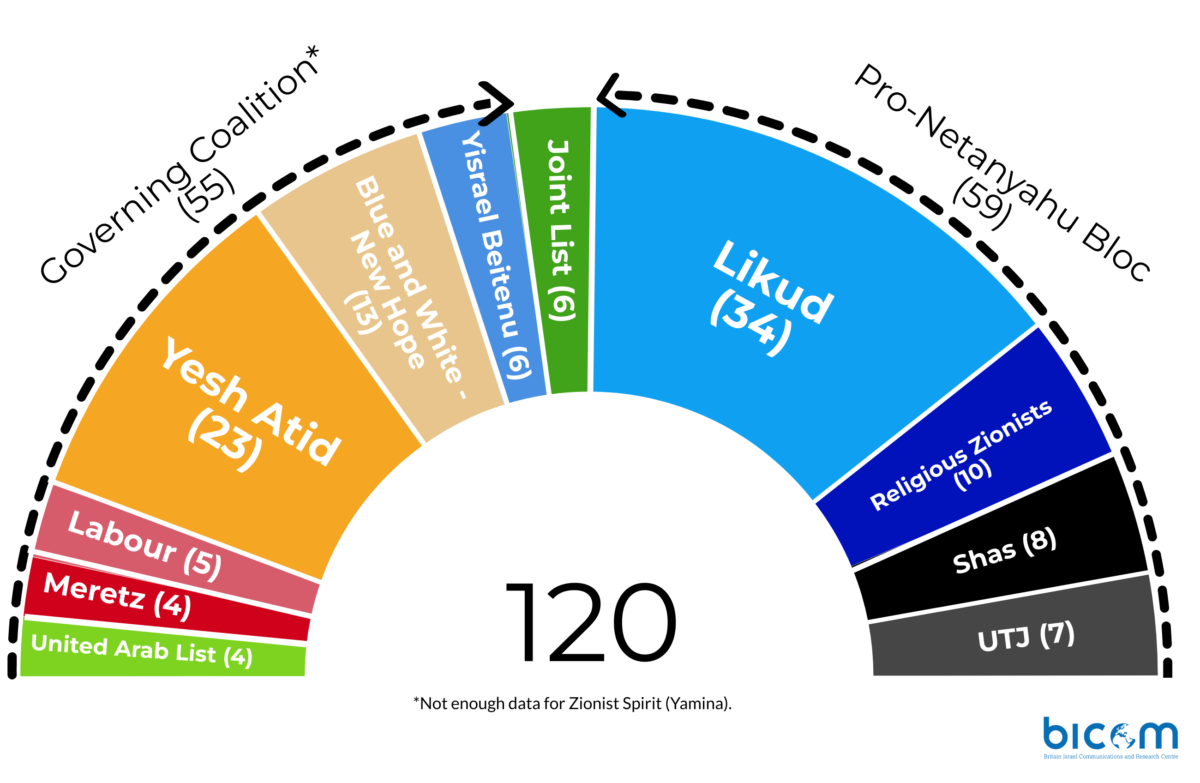
Positions on key political and security issues by Party
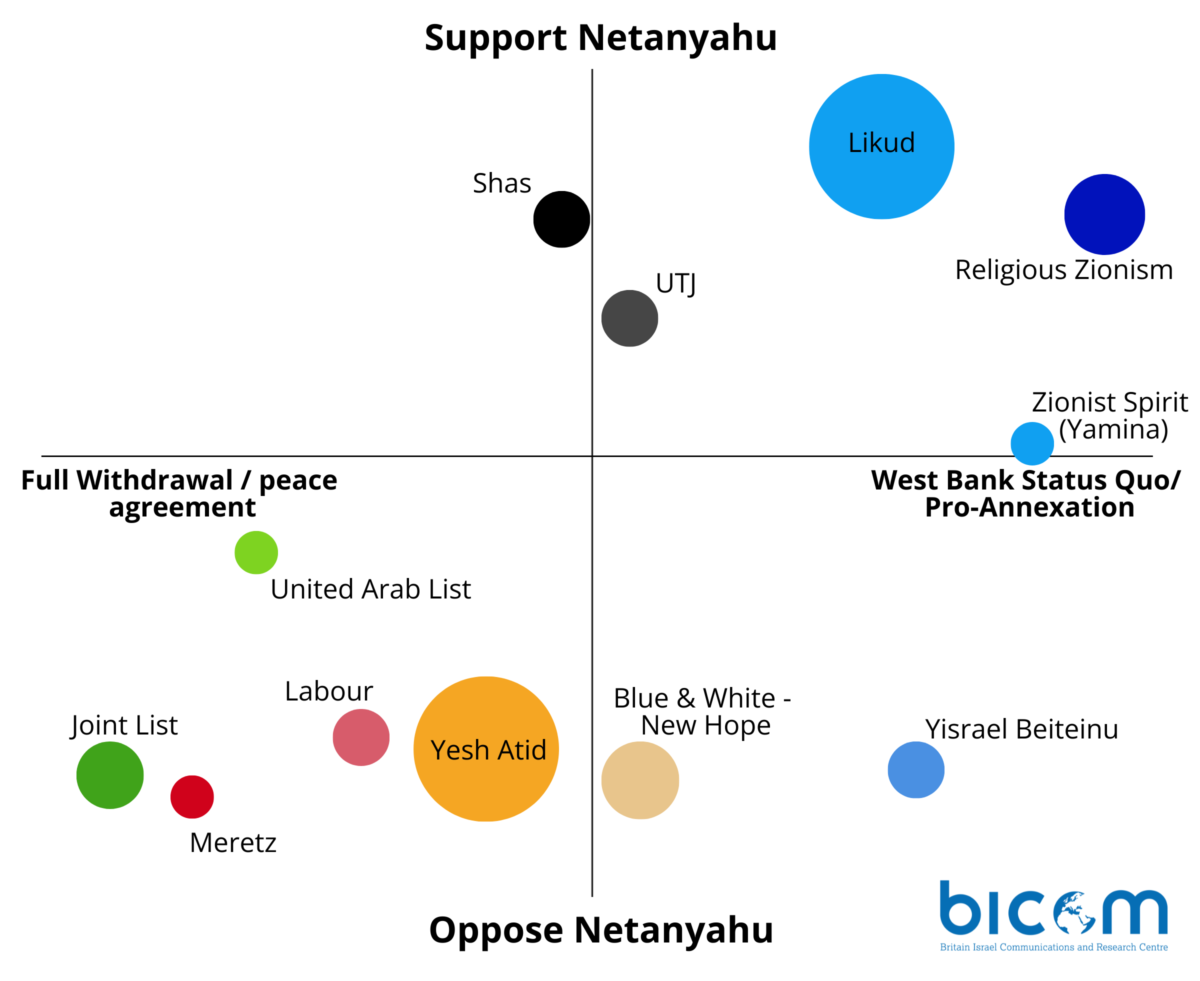
Likud
Current seats 30
Seats won in the last election – 34
Likud chairman Benjamin Netanyahu is set to remain party leader, following Yuli Edelstein’s withdrawal from the leadership race in late June having cited the need for party unity. Likud is scheduled to hold its primaries for its Knesset slate on August 10, although battles over who will choose representatives from the districts to stand in the primaries may cause a delay.
Following a year in opposition, Likud is seeking to galvanise support by focusing on the high ‘cost of living’. It is also carrying out a field campaign dedicated to fighting voter apathy, particularly among traditional Likud voters who stayed at home last time around (the party lost approximately 300,000 votes between the elections in March 2020 and March 2021), and fighting for wavering “soft right-wing” votes. Netanyahu is wary of candidates gaining notoriety with populist / extremist comments, that may be a turn off for mainstream voters, and has instructed party MKs to refrain from making controversial statements. Some of the Likud MKs have taken increasingly radical stances in the lead up to the primaries. For example, Yoav Kish talked about replacing the Attorney General if she allowed the appointment of a new IDF Chief of Staff by a transition government and Miri Regev said Netanyahu’s criminal trial should be stopped ahead of the election. Netanyahu’s inner circle wants to avoid embarrassing media incidents or grassroots initiatives, like the golden Netanyahu pendant.
While Netanyahu’s corruption trial continues, it is not expected to have a major influence on voting as many voters have formed an opinion on the matter and priced this into their calculation. Moreover, Netanyahu is still most preferred candidate among Israelis to be prime minister, and thus is the Likud’s main campaigning asset.
Not sure it’s necessary at this stage.
 Picture: Yediot Ahronot, Standing outside a conference for Likud party activists, a nervous Netanyahu hands out books about manners and appropriate behaviour.
Picture: Yediot Ahronot, Standing outside a conference for Likud party activists, a nervous Netanyahu hands out books about manners and appropriate behaviour.
Yesh Atid
Currently polling at 23 seats
Seats won in last election – 17
Yesh Atid leader Yair Lapid enters the election period as interim Prime Minister, a position that may strengthen him amongst some undecideds. Early polling firmly puts Yesh Atid as the second-largest party behind Likud and the largest party in the anti-Netanyahu bloc.
More significant is that Lapid is increasingly seen by the public as a suitable candidate for prime minister when compared to Netanyahu. The party’s biggest challenge is to increase its parliamentary strength without undermining (or pushing under the threshold) the smaller parties in the anti-Netanyahu camp, especially Labour and Meretz. The narrower the gap between Yesh Atid and Likud, the better Lapid’s chance will be to gain the mandate from the president to form the next government after the election.
In a speech to his party, Lapid said the election was an opportunity to form a “broad and stable national government, without the extremists,” which was taken to mean the exclusion of the Religious Zionist party and the Joint List. The same week, Lapid said that there were extremists on one side who called on the state to expel all of its Arab minority, while the other extreme wants a state without its Jewish character, adding that neither will happen. Such messaging may be an attempt to undermine Netanyahu’s argument that the election is between Bibi (Netanyahu) and (Ahmed) Tibi (an MK from the Joint List). In previous campaigns Lapid said he would be open to forming a government that relied on the support of the Joint List from outside the coalition. Lapid hopes he will convince former IDF Chief of Staff Gadi Eisenkot to join his party and take the second or third spot on the list, thereby alleviating the concerns of centre-right voters who see Lapid as not having enough experience on important security matters.
 Picture: Calcalist, While Lapid seeks to present the Boden visit and the Jerusalem Declaration as achievements, the high cost of living will end up being his downfall.
Picture: Calcalist, While Lapid seeks to present the Boden visit and the Jerusalem Declaration as achievements, the high cost of living will end up being his downfall.
Blue and White – New Hope
Currently polling at 13 seats
Seats won in last election – 8 Blue and White, 6 New Hope
Benny Gantz and Gideon Saar were the first to announce a new political merger ahead of the upcoming election, creating a new list called: “Blue and White-New Hope.” Gantz will head the united list, followed by Saar, and then the parties alternate down the list. Saar described the venture as the embodiment of the “stately right and security centre” and both leaders said they would refuse to sit in a government with Netanyahu.
Saar and Gantz felt that united they would be stronger than the sum of their respective parts although this has so far not been reflected so far in the polls. (In the previous election Blue and White received 8 seats and New Hope 6 seats). Gantz also hopes to Eisenkot in the new party. As a popular former Chief of Staff, Eisenkot is considered able to bring more centre-right votes to whichever party he joins.
The merger seeks to achieve several goals: It guarantees that New Hope will pass the electoral threshold; it hopes to place Gantz as a candidate for Prime Minister, which would undermine Netanyahu positioning the electoral choice as binary between him and Lapid; and because Gantz has better relations with the ultra-Orthodox than Lapid, it opens up a potential route for Gantz to create a coalition of 61 after the elections.
The party’s main challenge will be to establish a credible and clearly defined message, given the different competing political ideologies that make-up the party list. According to an internal study complied after the merge, two main issues that the party will stress are: The need to form a broad government without any extremist parties from either side, and the need to restore stately behaviour.

Picture: Haaretz, being interviewed for the TV reality show ‘married at first sight’ Gantz and Saar – who like in all traditional Jewish weddings – are about to break a glass, are asked by the presenters how committed they are to the process. In the background are other couples who are considering political merges – Itamar Ben-Gvir and Betzalel Smotrich of the Religious Zionist party, and Zehava Galon or Meretz and Merav Michaeli of Labour.
Religious Zionist Party
Currently polling at 10 seats
Seats won in last election – 6
Shortly after the fall of the Knesset, the Jewish Power faction headed by Itamar Ben-Gvir announced a technical split from the Religious Zionist Party, to allow it to negotiate a slighter higher proportion of representation on the election committee. While Ben-Gvir will likely re-join, disagreement remains with National Union chair Bezalel Smotrich over the composition of the Knesset slate and the relative balance of power between the factions, especially as a recent poll suggested that Ben-Gvir enjoys greater popularity. Ben-Gvir wants to finalise the list before the Religious Zionist Party holds its first-ever primary election on August 23 to translate his rising popularity into better placing on the joint slate. The party is also set to embrace a joint leadership model.
The Likud are pushing for both parties to merge again to maximise the electoral strength to the right of the party. The Religious Zionist Party may also target the approximate two seats worth of former Yamina voters who now feel they have no political home. Netanyahu wants Ben Gvir and Smotrich to be strong because they are loyal to him on matters such as (opposing) legislation that would prevent a person under criminal indictment from serving as prime minister and reforming the judiciary. On the other hand, Netanyahu will want to make sure they are not so strong that they have the power to force him to adopt policies that are too far to the right.
Picture: Israel Hayom, Bezalel Smotrich and Itamar Ben-Gvir inspect a mis-shapen bike. The agent tells them that ‘this is the most popular model these days – Gantz and Saar have already bought one while Zehava Galon, [the prospective Meretz leader] and Labour leader Merav Michaeli are interested in it.’
Shas and United Torah Judaism (UTJ)
Currently polling at 8 seats and 7 seats
Seats won in last election – 9 for Shas, 7 for UTJ
Both parties are seeking to win back votes that were lost between the 2019 and 2021 elections (over 35,000 for Shas and over 26,000 for UTJ). At the same time, they are facing an uphill battle to stem the flight of traditional UTJ and Shas voters to other parties.
Shas’ leaders are hoping that after the pro-Netanyahu right-wing bloc was forced from power, its supporters will bounce back and maximise the party’s potential. At the same time, there is concern that a large percentage of the party’s potential voters – those who support Shas but also admire Netanyahu and Likud — will ultimately cast their ballots for the latter. Party chairman Aryeh Deri has campaigned strengthening Shas’ grassroots strength by gathering the party’s MKs and local party representatives for talks on this subject.
UTJ’s task has become is more complicated due to the increased popularity of Bezalel Smotrich and Itamar Ben-Gvir amongst young ultra-Orthodox. UTJ is also dealing with internal tensions between the party’s two constituent factions, Degel Hatorah and the Hassidic Agudat Yisrael, over who will lead the party. Although the factions have traditionally taken it in turns to lead the joint list, Degel Hatorah head Moshe Gafni is refusing to hand the reigns to Yitzhak Goldknopf, the new UTJ Chairman (from Agudat Yisrael), arguing that Goldknopf is “a man who hasn’t spent even a single day in the Knesset,” adding that: “We’re the ones who deliver most of the votes. We have the most extensive experience and the most voters.” Ultimately though, this crisis is expected to be resolved, primarily due to the inability of the separate components to pass the electoral threshold on their own.
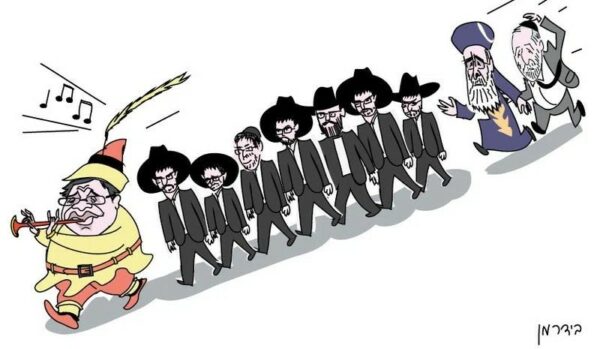 Picture: Haaretz, the pied piper, in the form of Itamar Ben-Gvir brings traditional ultra-Orthodox voters over to the Religious Zionism party, while the UTJ and Shas leaders are powerless to prevent it.
Picture: Haaretz, the pied piper, in the form of Itamar Ben-Gvir brings traditional ultra-Orthodox voters over to the Religious Zionism party, while the UTJ and Shas leaders are powerless to prevent it.
Yisrael Beiteinu
Currently polling at 6 seats
Current seats – 7
Current polling numbers suggest that Yisrael Beiteinu, headed by Avigdor Lieberman, is facing a drop in popularity, although polls have historically under-estimated the party’s electoral strength. Lieberman’s challenge is to repeat the seven Knesset seats he received in the last two elections to be able to influence the composition of a future coalition. Lieberman may seek to strengthen the immigrant voices in his party, whose public has traditionally formed the core of the party’s electoral base. He will also hope that he will not be damaged by his term as Finance Minister, in which he both succeeded in passing a budget (for the first time in three years) but also oversaw a rise in prices of basic utilities. Lieberman has ruled out any partnership with Netanyahu and the ultra-Orthodox parties, which arguably has led to the current stalemate in the Knesset between the pro- and anti-Netanyahu blocs.
The Joint List
Currently polling at 6 seats
Current seats – 6
The bitter rhetoric between the Arab parties – especially between the United Arab List (UAL) and the Joint List – is likely to continue. Ahmad Tibi recently called UAL leader Mansour Abbas an “ass-kisser” for Netanyahu during a Knesset row.
A challenge for all Arab parties is to increase voter turnout in Arab society. In April 2019, there was 49.2 per cent voter turnout in the Arab community, 59.2 per cent in September 2019, 64.8 per cent in March 2020 and approximately 45 per cent March 2021 (the last election was harder to estimate due to the rise in people voting remotely due to Covid). Recent polling within the Arab public suggests that only 40 per cent plan to vote in the coming election.
There are questions over whether the Joint List – comprised of Ahmad Tibi’s Taal (the Arab Movement for Renewal), Sami Abu Shehadeh’s Balad, and Ayman Odeh’s Hadash – will once again run together.
Balad party officials have said they are planning to run as an independent party in the upcoming elections. The main point of contention is the Joint List trying to position itself to influence Israeli politics from the inside and recommending Israeli Zionist politicians to the President to form a government in the aftermath of elections. Shehadeh recently said that it was not an option to be asked to ‘choose between the Gantz-Lapid right wing on one side and the Netanyahu-Smotrich right wing on the other side.’ Another party official said that ‘the time has come for a new, values-based political campaign that does not resemble the wishy-washiness of the UAL or the spirit of caving in that [is prevalent in] Hadash and Arab Movement for Renewal.’
Such a move – were it to happen – would likely have disastrous consequences for Arab political representation in the next Knesset, with Balad unlikely to pass the threshold, and the remaining Joint List components also potentially struggling to get the necessary votes.
Labour and Meretz
Currently polling at 5 seats and 4 seats
Seats won in last election – 7 for Labour, 6 for Meretz
Meretz leader Nitzan Horowitz has stood down, while ministers Tamar Zandberg and Esawi Frej have taken a time-out from politics. The party will be led by either current Meretz MK and former Deputy IDF Chief of Staff Yair Golan or former party leader Zehava Galon, who headed the party for a six-year stint. Golan or Galon will face a battle on 23 August to rehabilitate the party and to ’return’ former Meretz voters who have moved towards Yesh Atid, Labour, or the Joint List. Meretz suffered a blow from the debacle of rebel MK Ghaida Rinawie Zoabi, parachuted into the party by Horowitz but subsequently one of the MKs responsible for the collapse of the current coalition.
Meretz’s poor polling – the party is struggling to cross the threshold – has led to calls to merge with its ‘sister’ party, Labour. Incumbent Merav Michaeli became the first party leader not to be ousted after one term since the primaries system was introduced in the early 1990s when she convincingly won a second term as Labour Party leader with 82.5 per cent of the vote. Despite the lack of deep ideological differences between the parties, Michaeli and other Labour MKs have refuted calls to merge, fearing that they would lose mainstream support if they ran with Meretz. They also aspire to return the Labour party to a prominent position on the centre-left and not accept being perceived as a narrow-left wing party. “Merav Michaeli was elected by a sizeable majority based on the promise to restore the Labour Party to being a major political party and getting back to being part of power. This path does not go via Meretz,” said Labour Party Faction Chairman MK Ram Shefa.
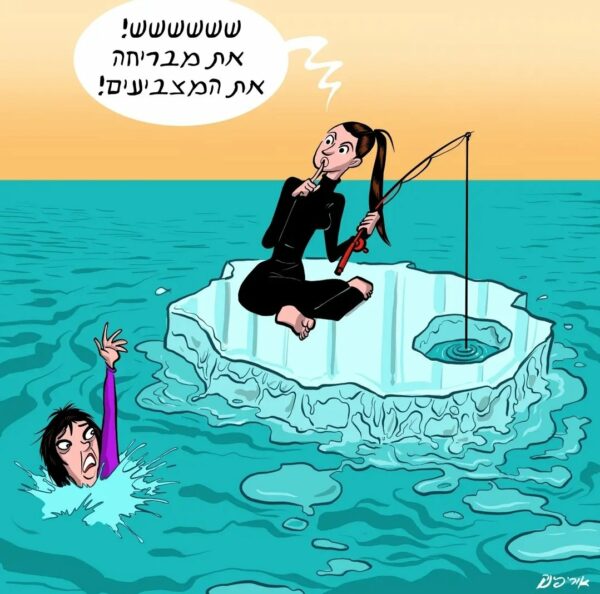 Picture: Maariv, as prospective Meretz leader Zehava Galon calls out to be saved, Labour leader Merav Michaeli tells her to be quiet as she is scaring away the voters.
Picture: Maariv, as prospective Meretz leader Zehava Galon calls out to be saved, Labour leader Merav Michaeli tells her to be quiet as she is scaring away the voters.
The United Arab List (UAL / Raam)
Currently polling at 4 seats
Seats won in last election – 4
United Arab List leader Mansour Abbas remains party head following his historic decision to lead the party into the previous government. In several recent interviews Abbas has said he remains clear-headed and confident in his conviction that Arab-Israeli citizens must embrace their civic identity and seek representation in Israel’s leadership. Abbas faces two main challenges: to convince the Arab public that his inclusion in the last government was more beneficial than remaining in the Opposition; and to try and increase the Arab turnout. Whilst the previous government approved 30 billion Shekels (£7.1bn) in funding allocated to fix historic neglect in Arab cities and towns as a key achievement, it did not have enough time to properly allocate the funds and thus many Arab citizens have not felt any meaningful change in their communities.
He is also fighting off attacks from Netanyahu describing his party as terror supporters (before Abbas joined the Bennett-Lapid coalition he was courted by Netanyahu). When Likud MK David Amsalem recently said that the UAL could potentially be part of a future Netanyahu led coalition (if the coalition had 61 seats without them), Netanyahu doubled down calling Abbas’ party ‘anti-Semitic, anti-Zionist and supports terrorism’.
 Picture: Yediot Ahronot, Abbas is greeted by Likud MK David Amsalem while Netanyahu tries to distance himself. Before Abbas joined the Bennett-Lapid government he was courted by Netanyahu.
Picture: Yediot Ahronot, Abbas is greeted by Likud MK David Amsalem while Netanyahu tries to distance himself. Before Abbas joined the Bennett-Lapid government he was courted by Netanyahu.
Zionist Spirit (Yamina and Derech Eretz)
Not enough accurate polling data
Seats won in last election – 7 for Yamina, 2 for Derech Eretz (as part of New Hope)
‘Zionist Spirit’ was formed by Ayelet Shaked of Yamina and Yoaz Hendel of Derech Eretz (formerly a faction within Gideon Saar’s New Hope), two right-wing parties who were struggling to reach the electoral threshold. Shaked and Hendel have stressed they will do everything possible to form a unity government rather than a narrow Netanyahu-led right-wing government. At the same time, Shaked has refused to rule out Netanyahu and has described her ideal government as including Likud, Blue and White-New Hope and other forces from the political right, which she believes would reflect the wishes of large swaths of the public.
How Zionist Spirit hope to convince members of the anti-Netanyahu camp (including those who feel burned by him in the recent past) to sit in a government with him has not been detailed. Moreover, Shaked has come under fire from Likud MKs who have tarnished her as a major player in the previous ‘left-wing’ government and the anti-Netanyahu bloc. The new party is hovering around the electoral threshold. But if it were to pass, and the pro and anti-Netanyahu bloc remain tied, Shaked would be in a position to crown Netanyahu the new Prime Minister if she so wished.
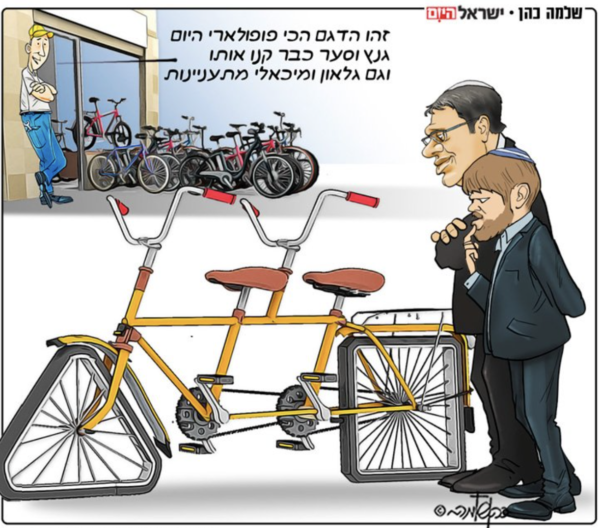
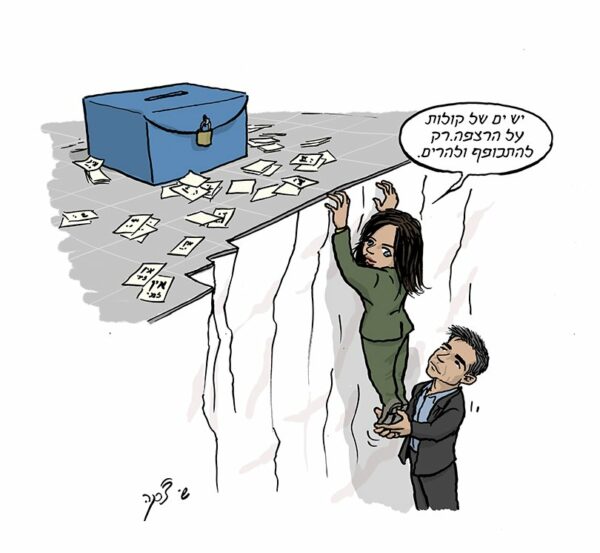 Picture: Makor Rishon, claiming that there are lots of votes ‘on the floor’ and they just need to bend down and pick them up, Hendel and Shaked struggle to climb up a mountain to reach the necessary votes. Zionist Spirit have said they believe there are enough votes amongst the right wing who neither support Netanyahu or the hardline Religious Zionist party (and are not keen on former Likud MK Gideon Saar who recently joined Benny Ganz) to support their joint venture.
Picture: Makor Rishon, claiming that there are lots of votes ‘on the floor’ and they just need to bend down and pick them up, Hendel and Shaked struggle to climb up a mountain to reach the necessary votes. Zionist Spirit have said they believe there are enough votes amongst the right wing who neither support Netanyahu or the hardline Religious Zionist party (and are not keen on former Likud MK Gideon Saar who recently joined Benny Ganz) to support their joint venture.